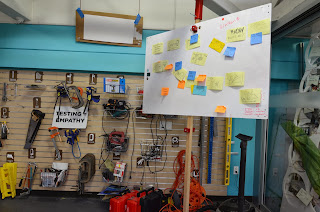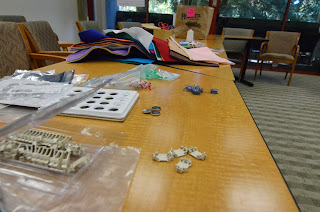I feel I've developed some personally solid understanding of design thinking overall, and we have some great babysteps in place incorporating design thinking into things like service learning, classroom spaces, special events... nice school/community projects like that. Our design thinking committee today even did the d.school Crash Course together, but instead of focusing on "the gift giving experience," teachers redesigned pain points for each other ranging from aspects of our student applicant visits to classroom transitions to course reflections. I'm not saying we're experts, but we're well on our way towards deep implementation of these ideas at a sort of systemic level! (*pats self and colleagues on back*)
Yes, and...
I'm still not sure how to apply design thinking *in my science classroom!*
I've long been a proponent of project-based learning (PBL). I'm super excited about #makered, and my kids have been building and engineering towards academic purposes since I started teaching. (Couple of serious throw-back links in there...) And I will continue using project-based learning, engineering, and "making" in my classroom while incorporating babysteps of design thinking, through bits and pieces of awesome new brainstorming/ideation techniques, fabulous positive critical feedback scaffolds, and structures for iterations that I've been learning while learning about design thinking.
Yes, and...
What does fully-fledged design thinking look like in the content context? How do I create a design thinking prompt that will also lead students towards critical content understanding?
The critical jump from engineering-design PBL to Design Thinking seems to be empathy... My students can learn excellent content through a project to design and build a boat that will hold X weight and travel Y distance, but does the user matter in that case? My colleague Santosh is leading a fabulous design engineering exercise right now in which kids are designing devices to burn a chip and measure the heat produced... it can't be "design thinking" because there's no user for whom to probe needs, right?
Now, I'm not saying that every single project *must* be design thinking! I'm wondering... how and where can I bring more empathy into my content-focused courses, and create prompts and scaffold experiences that go deeply into design thinking like those service learning design projects and classroom environment re-design projects that we're diving into?
For example:
- Kim Saxe describes this incredible project in 6th grade Health classes that involve redesigning aspects of health care experiences.
- St. Marten's Episcopal in New Orleans just posted to #dtk12chat this beautiful Spanish class design thinking content project in which students are investigating illegal organ trade.
- Heather Pang's incredible monuments-to-great-American-women project has many beautiful elements of design thinking for her social studies content (although I don't know if Heather herself would call it design thinking.)
- An awesome physical education teacher I met this weekend at EdCampPSWA (Puget Sound Washington) has a new plan to have his students create healthy-for-life exercise games with MakeyMakey as final projects.
- Project Ventura at Ann Richards School for Young Women Leaders is an incredible ongoing engineering design project with clear end users - definitely design thinking, though I don't think I've ever heard them define it as design thinking.
So, in tomorrow's #dtk12chat, I'm hoping to collaborate with other participants to pull out (1) how we're already using elements of design thinking in our academic content-focused pursuits, (2) examples of fully-fledged deep design thinking projects in those areas, and (3) maybe piece together some philosophies and tips for developing new prompts to support more design thinking in the content areas.
Yep, that's the idea. We'll see how it goes...






















































